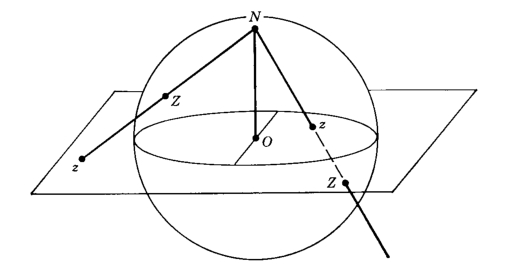I think I managed to write it properly.
Let's denote the stereographic projection from $\Bbb C$ to the sphere by $\varphi$. Let's denote $C(a,R)$ the circle with center $a$ and radius $R$.
Assume first that $a\in[0,\infty[$. Then since $\varphi$ maps circles into circles, the diameter of the circle image is $$D = \sup\{d(\varphi(z),\varphi(a+R)):z\in C(a,R)\}.$$
The approach is to find a bound for $$\{d(\varphi(z),\varphi(a+R)):z\in C(a,R)\}$$
and then see that the bound is reached at a point in the circle so it has to be the sup.
So, observe that
\begin{align} d(\varphi(z),\varphi(a+R)) &= \frac{2\lvert z - (a+R)\rvert}{\sqrt{(1+\lvert z\rvert^2)(1+\lvert a + R\rvert^2)}} \\ &\leq \frac{2(\lvert z-a\rvert + R)}{\sqrt{(1+\lvert z\rvert^2)(1+\lvert a + R\rvert^2)}} \\ &= \frac{4R}{\sqrt{(1+\lvert z\rvert^2)(1+\lvert a + R\rvert^2)}} \tag{1} \end{align}
In the other hand, if $z = x + iy$ is in $C(a,R)$ then $$ R^2 = (x-a)^2 + y^2,$$
so
\begin{align} \lvert z \rvert^2 &= x^2 + R^2 - (x-a)^2 \\ &= x^2 + R^2 - x^2 + 2xa - a^2 \\ &= R^2 + 2xa - a^2\tag{2} \end{align}
but since $z$ is in the circle $\Re z = x \in [a-R,a+R]$. So by (2) \begin{align} \lvert z \rvert^2 &= R^2 + 2xa - a^2 \\ &\geq R^2 + 2(a-R)a - a^2 \\ &= (a-R)^2. \end{align}
So
\begin{align} 1 + \lvert z\rvert^2 &\geq 1 + (a-R)^2 \\ \frac{1}{\sqrt{1 + \lvert z\rvert^2}} &\leq \frac{1}{\sqrt{1 + (a-R)^2}}. \end{align}
By (1)
$$ d(z,a+R) \leq \frac{4R}{\sqrt{(1+\lvert a - R\rvert^2)(1+\lvert a+R\rvert^2)}} $$
and the bound is reached at $z=a-R$, so the radius is $$\frac{2R}{\sqrt{(1+\lvert a - R\rvert^2)(1+\lvert a+R\rvert^2)}}.$$
Now, notice that the formula $$d(\varphi(z),\varphi(z'))=\frac{2|z-z'|}{\sqrt{(1+|z|^2)(1+|z'|^2)}}$$ is invariant under rotations.
So if $a\in\Bbb C \setminus [0,\infty[$, in particular it is not $0$, so rotate by $\frac{\bar a}{\lvert a \rvert}$ and we are done.

